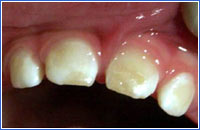Etiology: Teeth
Any tooth surface can develop a cavity, but some surfaces are more prone, including newly erupted teeth due to immature enamel and teeth with developmental defects.
Nature of Enamel Defects
The cells that manufacture enamel are very sensitive to systemic insults. Disruption in the enamel production during tooth development will result in a defect which may be microscopic or macroscopic.
- 20-40% percent of children have developmental defects of enamel.
- Defects may appear as changes in translucency, color, or texture.
- It may be difficult to distinguish enamel defects from early clinical signs of caries though this does not affect management.
- Enamel defects are associated with substantially increased risk of ECC.
- Increased incidence of enamel defects is associated with:
- Lower socioeconomic status (SES)
- Children born prematurely
- Children with certain congenital and genetic diseases and other children with special needs, such as children with cerebral palsy and intellectual disabilities
Developmental Defects of Enamel


References
Oliveira AF, Chaves AM, Rosenblatt A. The influence of enamel defects on the development of early childhood caries in a population with low socioeconomic status: a longitudinal study. Caries Res. 2006;40(4):296-302.
Targino AG, Rosenblatt A, Oliveira AF, Chaves AM, Santos VE. The relationship of enamel defects and caries: a cohort study. Oral Dis. 2011 May;17(4):420-6.
Jacobsen PE, Haubek D, Henriksen TB, et al. Developmental enamel defects in children born preterm: a systematic review. Eur J Oral Sci. 2014; 122(1):7-14.